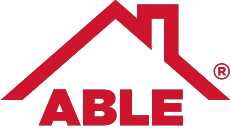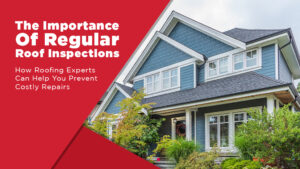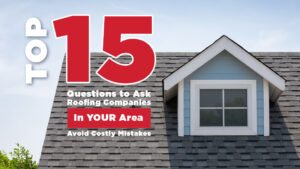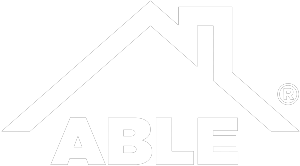As the days grow shorter and the leaves begin to change color, it’s natural to start thinking about all the things we are thankful for. From our family and friends to our health and homes, there’s a lot to be grateful for. This Thanksgiving, take a second to appreciate the unsung hero of our homes: the roof.
Your roof is one of the most important parts of your home. It is designed to protect you from the elements, keeping you safe and comfortable indoors. When it’s working properly, you probably don’t even give it a second thought. But when something goes wrong, it quickly becomes the center of your attention and brings you a lot of stress. Leaks, missing shingles, and other damage can all lead to big problems if not addressed in a timely manner. That’s why it’s so important to have a roof that is in good condition and to keep up with regular maintenance. By better understanding how your roof works and what it does for your home, you can be sure to show it the appreciation it deserves.
The anatomy of your roof
Your roof is made up of several different layers, each of which serves a specific purpose. The outermost layer is called the shingles. This is the layer that you can see from the ground, and it’s what comes to mind first for most people when they think of a roof. The shingles work to keep water from seeping into your home and causing damage. They also provide some insulation and help regulate the temperature inside your home.
Beneath the shingles is a layer of felt paper. This layer helps to protect your home from wind and fire. It’s also important for keeping the shingles in place. The next layer is made up of the roof deck, which is usually made of plywood or OSB. This is the layer that provides support for the shingles and helps to distribute their weight evenly.
The final layer is the insulation. This is what helps to keep your home cool in the summer and warm in the winter. It’s important to maintain a comfortable indoor temperature and reduce energy bills.
Protection 1: keeping water out
One of the most important functions of your roof is to keep water from entering your home. When it rains or snows, the water can seep through cracks and holes in your roof and cause damage to your home. This water damage leads to mold growth, rot, and structural problems. Your roof works to prevent this damage by creating a barrier between your home and the outside elements.
The first line of defense against water damage is your roof’s shingles. These are the overlapping, waterproof tiles that you can see on the outside of your home. They work to keep water from seeping through the cracks and holes in your roof. The felt paper beneath the shingles also helps to keep water out by providing an additional layer of protection.
The insulation in your roof also plays a role in keeping water out. This is because it helps to fill in any gaps or cracks in your roof. Doing prevents water from seeping through and causing damage to your home. When a roof fails to adequately protect your home from water damage, it’s usually due to a problem with the shingles or insulation. A clear sign that your roof is not protecting your home from water damage is a leak in the ceiling. If you see a leak, have it fixed as soon as possible to prevent further damage.
Protection 2: keeping you comfortable
Another critical function of your roof is to regulate the temperature inside your home. In the summer, your roof works to keep your home cool by reflecting the sun’s heat away. In the winter, it works to keep your home warm by trapping heat inside. This regulation of temperature is important for maintaining a comfortable indoor environment. It’s also essential for reducing your energy bills.
The shingles on your roof are designed to reflect the sun’s heat away from your home. This helps to keep your home cool in the summer and reduces your air conditioning costs. The roof insulation also helps keep your home cool by trapping cooler air inside. In the winter, this same insulation works to keep heat from escaping your home. This helps to keep your home warm and reduces your heating costs.
If you’re not comfortable in your home despite how much you adjust the thermostat, it could be a sign your roof is not properly regulating the temperature. This is usually due to a problem with the shingles or the insulation. If you think your roof is not regulating the temperature properly, it’s important to have it checked by a professional.
Protection 3: keeping your home safe
Your roof also keeps your home safe from some of the most damaging weather conditions. These include high winds, hail, and fallen trees.
When high winds blow, they can cause weak or previously damaged shingles to come off of your roof. This exposes the underlying layers of your roof to the elements and can cause further damage. In extreme cases, high winds can even cause an entire section of your roof to collapse. This exposes your home to the elements, can put you and your family in danger and can damage any belongings inside your home.
Hail can also damage your roof. Hailstones can fall at high speeds and break through the shingles on your roof. Hail is made up of hard, compacted ice that can penetrate your roof and cause damage to the underlying layers. This damage can lead to leaks, mold growth, and structural problems.
Your roof also protects you from other hazards such as fallen tree limbs. However, if your roof is failing or weakened, it may not be able to withstand the impact of falling trees or their limbs. With enough force during a storm, tree limbs can crash through your roof and cause damage to the inside of your home. Additionally, these limbs can fall on electrical wires leading to your home, which can be a fire hazard. Look around the direct perimeter of your home for any trees that may threaten your roof in the event of high winds. The more cognizant you are of these potential hazards, the better prepared you will be to protect your home.
Protection 4: the value of your home
A home is an investment. Like any significant investment, you want to protect it comprehensively to avoid losing money in the future if you decide to sell. Your roof is a big part of that protection.
A well-maintained roof can last for decades, and it will add value to your home should you eventually sell. On the other hand, a roof that is in disrepair can shorten the lifespan of your home and make it harder to sell. When buyers see a home with a damaged or old roof, they are discouraged by the prospect of an immediate and expensive repair. This can be a deterrent for even the most interested buyer. Any issues indoors that occurred because of a damaged roof will also need to be repaired before you can sell, further adding to the cost.
By keeping your roof well-maintained, you are protecting your investment and ensuring that your home will be valuable when the time comes to sell. Buyers will be impressed by a home with a strong, durable roof and will be more likely to make an offer.
Protection 5: healthy home ventilation
Your roof also plays a role in keeping your home’s indoor air quality healthy. Proper ventilation prevents mold growth, reduces allergens, and eliminates odors.
Mold can grow in any home, but it is more likely to develop in homes that are not properly ventilated. Mold needs two things to grow: moisture and a food source. In your home, the food source is typically dust or dirt. When mold spores land on a dust particle, they start to grow. To prevent mold growth, it is important to reduce the moisture in your home. This can be done by ensuring your home is properly ventilated.
Allergens can also be reduced by proper ventilation. Allergens are tiny particles that can cause allergic reactions. They are found in dust, pollen, and pet dander. When these particles are airborne, they trigger allergies. By ventilating your home, you can reduce the number of allergens in the air and create a healthier environment to live in.
Odors can also be eliminated by proper ventilation. Odors are caused by gases that build up in your home. These gases can come from cooking, smoking, pets, and cleaning products. When these gases are not properly ventilated, they can cause odors. By ventilating your home, you can remove these odors and create a fresher, more pleasant environment.
Your roof plays an integral role in protecting your home. By keeping your roof well-maintained, you are protecting your most prized possessions that live underneath it. From your family to your pets to your home itself, there are many things that you can thank your roof for protecting. This Thanksgiving, be sure to give your roof a little extra love and connect with a roofing professional to ensure that your roof is in optimal condition.








